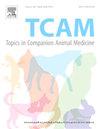巴西东北部地区家庭和收容所犬中克氏锥虫的血清患病率。
IF 1.3
3区 农林科学
Q2 VETERINARY SCIENCES
引用次数: 0
摘要
在克氏锥虫的环境循环中,狗作为圈养宿主和潜在哨兵发挥着至关重要的作用。然而,尽管它们与“同一个健康”相关,但关于克氏t型虫在犬中分布的血清流行病学研究仍然很少。因此,本研究旨在确定抗t的频率。在巴西东北部阿拉戈斯州阿拉皮拉卡市的家庭和收容所的狗中发现克鲁兹病毒IgG抗体。对来自两个收容所的150只狗和150只家养狗的血清样本进行了IgG抗t检测。采用免疫荧光抗体试验(IFAT)检测克氏抗体(临界值≥1:40)。采用单因素分析调查与寄生虫血清阳性相关的因素。在这些动物中,9.0%(27/300)的抗t抗体检测呈阳性。cruzi抗体。收容犬(频率 = 77.8%;21/27)的比值比(OR) = 3.29 (95% CI [1.25 - 8.64];P = 0.0156),而家犬(频率 = 22.2%;6/27)。这项研究的结果表明,收容所的狗更容易受到感染,可以作为当地恰加斯病控制项目的哨兵动物,以预测人群中病例的出现。本文章由计算机程序翻译,如有差异,请以英文原文为准。
Seroprevalence of Trypanosoma cruzi in household and shelter dogs in the northeastern region of Brazil
Dogs play a crucial role as peri-domestic reservoirs and potential sentinels in the environmental circulation of Trypanosoma cruzi. However, despite their relevance to One Health, seroepidemiological studies on the distribution of T. cruzi in dogs remain scarce. Thus, this study aimed to determine the frequency of anti-T. cruzi IgG antibodies in household and shelter dogs in the municipality of Arapiraca, Alagoas, in the northeastern region of Brazil. Serum samples from 150 dogs from two shelters and 150 from household dogs were tested for IgG anti-T. cruzi antibodies using the Immunofluorescent Antibody Test (IFAT) (cut-off ≥ 1:40). Univariate analysis was employed to investigate factors associated with seropositivity for the parasite. Of the animals, 9.0% (27/300) tested positive for anti-T. cruzi antibodies. Shelter dogs (frequency = 77.8%; 21/27) exhibited an odds ratio (OR) = 3.29 (95% CI [1.25 – 8.64]; p = 0.0156) compared to household dogs (frequency = 22.2%; 6/27). The results of this study indicate that shelter dogs are more exposed to the infection and can be used as sentinel animals in local Chagas disease control programs to predict the emergence of cases in human populations.
求助全文
通过发布文献求助,成功后即可免费获取论文全文。
去求助
来源期刊

Topics in companion animal medicine
农林科学-兽医学
CiteScore
2.30
自引率
0.00%
发文量
60
审稿时长
88 days
期刊介绍:
Published quarterly, Topics in Companion Animal Medicine is a peer-reviewed veterinary scientific journal dedicated to providing practitioners with the most recent advances in companion animal medicine. The journal publishes high quality original clinical research focusing on important topics in companion animal medicine.
 求助内容:
求助内容: 应助结果提醒方式:
应助结果提醒方式:


